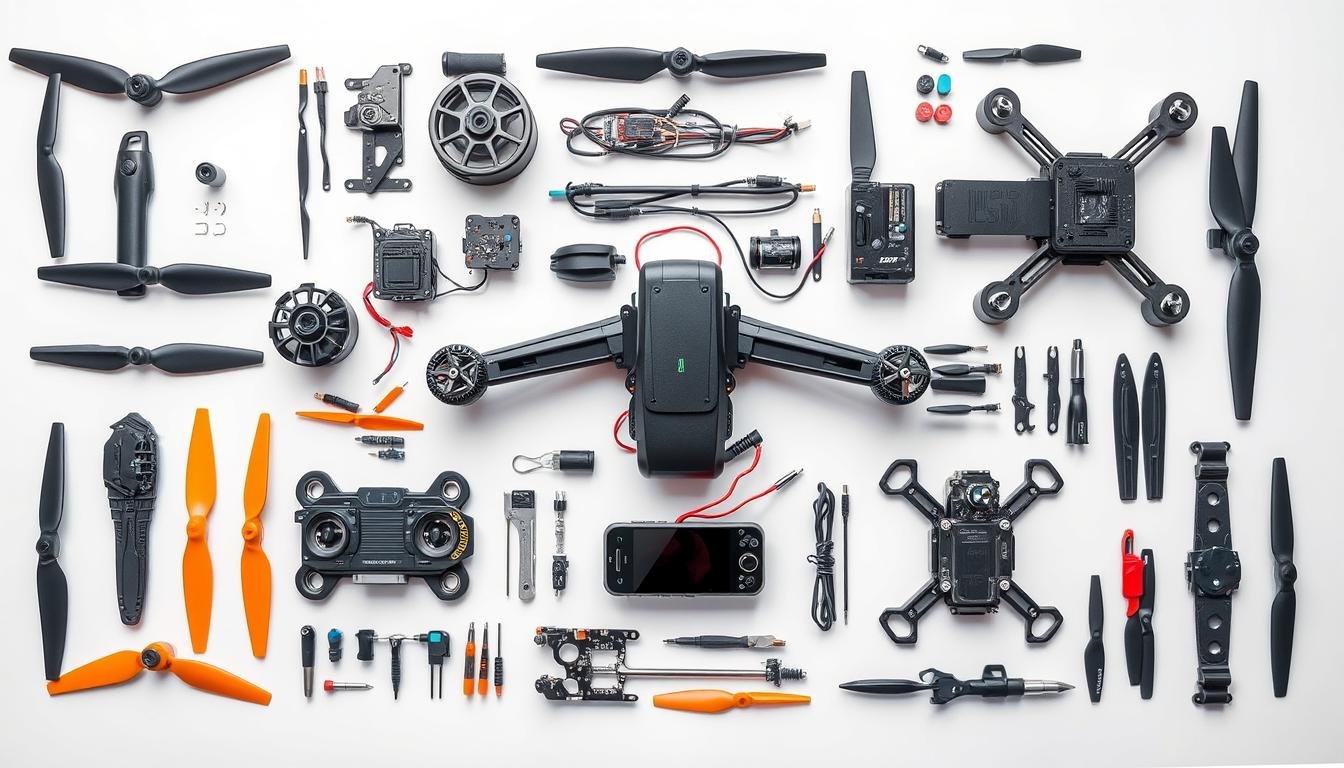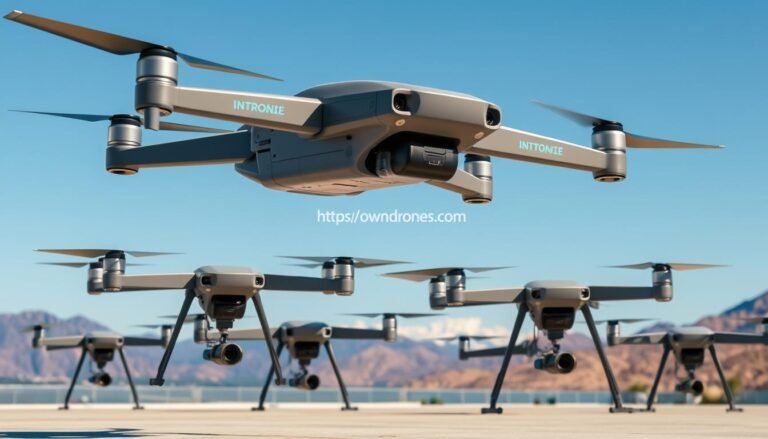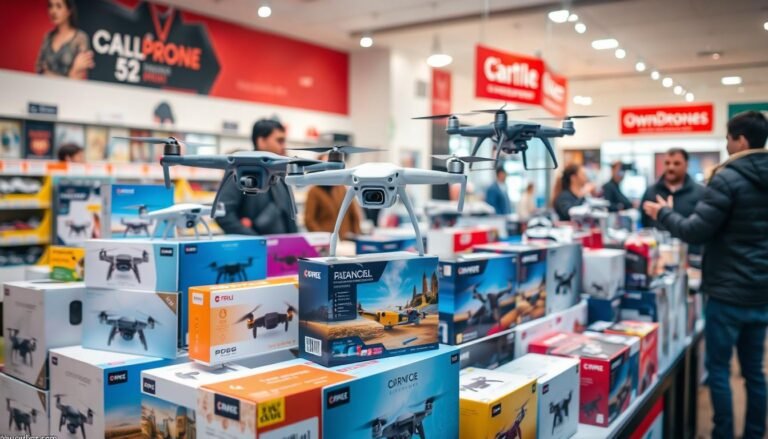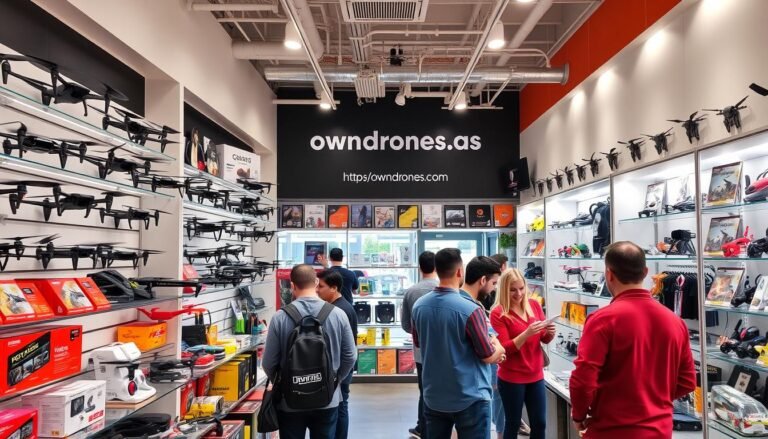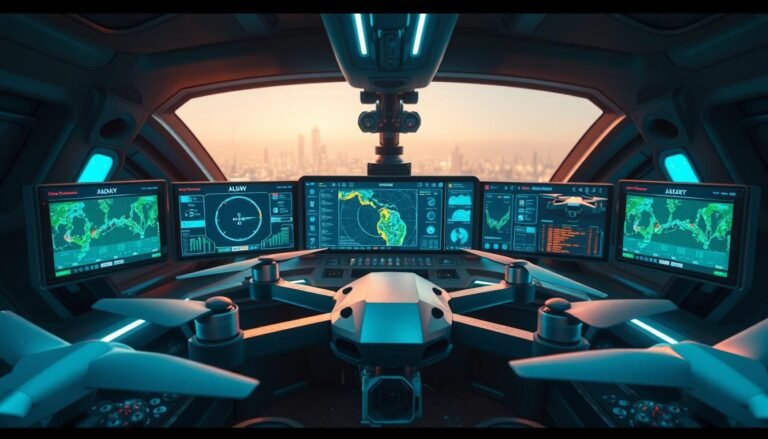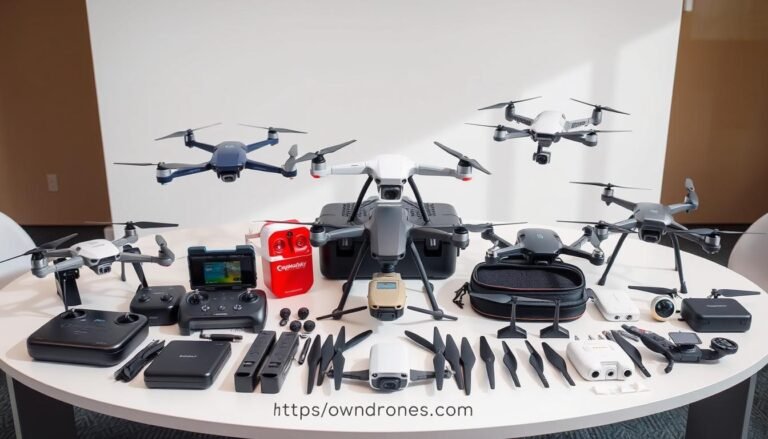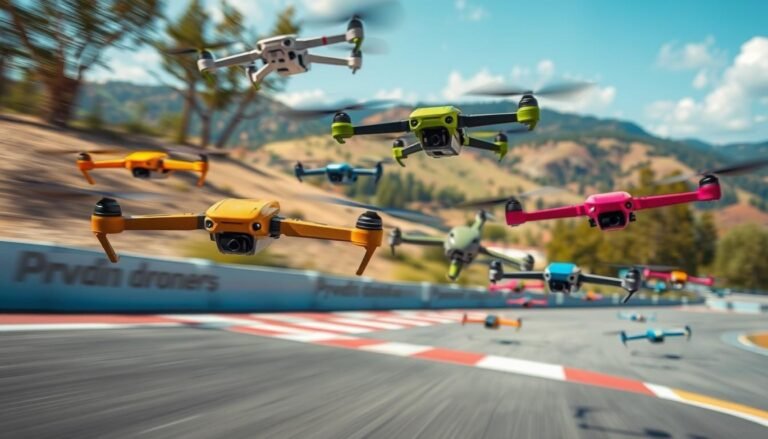Essential Drone Parts for DIY and Custom Builds
Building a custom drone is thrilling. It lets you create an aircraft that fits your needs perfectly. But where do you start? What parts do you need?
Creating a drone requires technical know-how and patience. You’ll need the right components too. Each part plays a crucial role in your drone’s performance.
This guide explores DIY drone building essentials. We’ll cover frames, motors, propellers, and flight controllers. You’ll learn how to choose the perfect parts for your project.
Get ready to unleash your creativity. You’ll soon be flying a drone you built yourself. Let’s discover the components that will make your dream drone a reality.
Key Takeaways
- Essential drone parts include the frame, motors, propellers, flight controller, ESCs, battery, and radio control system.
- Building a custom drone allows for personalization, cost savings, and educational opportunities.
- Selecting the right components based on specific needs and preferences is crucial for optimal performance.
- Understanding the compatibility and integration of different drone parts is essential for a successful build.
- Proper research, planning, and attention to detail are key to building a reliable and high-performing DIY drone.
Introduction to DIY Drone Building
Creating your own custom drone offers exciting possibilities and numerous benefits. You can tailor your drone to meet specific needs and preferences. This hands-on approach lets you explore the full potential of drone technology.
Benefits of Building Your Own Drone
A DIY drone gives you complete control over components, features, and aesthetics. You can optimize your aircraft for photography, racing, or long-range flights. This level of customization allows for endless possibilities.
Building your own drone can lead to significant cost savings. By carefully selecting parts, you can create a high-quality drone affordably. Your DIY build can rival commercial models without the hefty price tag.
Challenges and Considerations
DIY drone building comes with its share of challenges. It requires technical knowledge and skill to select compatible components and troubleshoot issues. However, with patience and research, these obstacles can be overcome.
Before starting your project, consider your budget, skills, and intended use. Research the components that best suit your needs and desired features. Familiarize yourself with local regulations to ensure responsible and legal drone operation.
Drone Frames
Drone frames are the backbone of custom builds. They hold components and shape the aircraft. Frames come in various configurations, materials, and sizes for different purposes.
Types of Drone Frames
Quadcopter frames are most common, with four arms in X or H layouts. They offer stability and versatility for many uses. Hexacopter and octocopter frames have six and eight arms.
These provide more lift and safety for heavy payloads. Frame materials affect drone durability and performance. Carbon fiber is popular for its strength and light weight.
Aluminum frames are also light and strong. Plastic frames are cheaper and work well for smaller builds.
Factors to Consider When Choosing a Frame
When picking a drone frame, think about these things:
- Size: Frame size affects drone dimensions, agility, stability, and payload capacity. Common sizes are 150mm, 250mm, and 450mm.
- Weight: Lighter frames allow longer flights and better control. Heavier frames are more stable in wind.
- Durability: Choose materials that can handle crashes, especially for beginners or challenging environments.
- Compatibility: Make sure the frame works with your chosen motors, ESCs, and flight controllers.
QAV, iFlight, and GEPRC are popular FPV drone frame brands. They’re known for quality and performance. Frame prices range from $15 to over $100.
| Frame Brand | Size | Material | Price Range |
|---|---|---|---|
| QAV | 250mm, 400mm | Carbon Fiber | $50 – $100 |
| iFlight | 150mm, 250mm | Carbon Fiber | $30 – $80 |
| GEPRC | 150mm, 200mm | Carbon Fiber, Aluminum | $20 – $60 |
A good drone frame is key to a successful DIY build. Pick one that fits your goals and flying style. It’ll help you create a custom drone that meets your needs.
Motors and Propellers
Selecting the right motors and propellers is vital for custom drone performance. Brushless motors are popular due to their power-to-weight ratio and durability. Key motor specs include KV rating, stator size, and weight.
Propellers vary in size, pitch, and materials, affecting flight traits and efficiency. Matching propellers to motors maximizes thrust and minimizes power use. Consider propeller diameter, pitch, and material when choosing.
DSLRPros offers OEM propellers from DJI, Autel, Parrot, and Teledyne FLIR SIRAS. They also provide third-party accessories from T-Motor and KDE for customization and high performance.
| Motor Specification | Description |
|---|---|
| KV Rating | RPM per volt, determines the motor’s speed and torque |
| Stator Size | Affects the motor’s power and efficiency |
| Weight | Impacts the drone’s overall weight and flight time |
Consider voltage, current, thrust-to-weight ratio, power, efficiency, and speed when choosing drone motors. The number of motors should match the recommended propeller count for efficient operation.
Choosing the right propellers for drones is crucial as they are designed to create air pressure differences that generate lift for flight.
Propeller guards from DSLRPros protect against damage during obstacle encounters. They reduce injury and property damage risks. Quality replacement parts can extend your drone’s lifespan and boost flight capabilities.
Flight Controllers
Flight controllers are the brain of any drone. They manage stabilization, navigation, and communication with other parts. These essential components ensure smooth and precise flight control in DIY or custom drone builds.
Many flight controllers are available in the market. Understanding their types, features, and capabilities is key to picking the right one for your project.
Types of Flight Controllers
Several flight controller types cater to different needs and preferences. Some popular options include:
- EMAX flight controllers, known for their advanced processors and onboard OSD support
- PIKO flight controllers, offering micro FPV capabilities and compatibility with various firmware
- MATEK flight controllers, featuring built-in OSD and multiple UART ports for expandability
- SP Racing flight controllers, renowned for their high-performance processors and extensive customization options
- RUSH flight controllers, providing excellent value with advanced features at competitive prices
Features and Capabilities
Flight controllers offer various features that boost drone performance and functionality. Key features to consider include:
| Feature | Description |
|---|---|
| Processor | High-performance processors like the STM32H743 ensure smooth operation and quick response times |
| Firmware Support | Compatibility with popular firmware such as Betaflight allows for extensive customization and tuning options |
| Onboard OSD | Integrated OSD (On-Screen Display) provides real-time flight data and telemetry information |
| Sensor Integration | Built-in sensors like gyroscopes, accelerometers, and barometers enhance flight stability and control |
| Expandability | Multiple UART ports and I/O pins allow for the connection of additional accessories and modules |
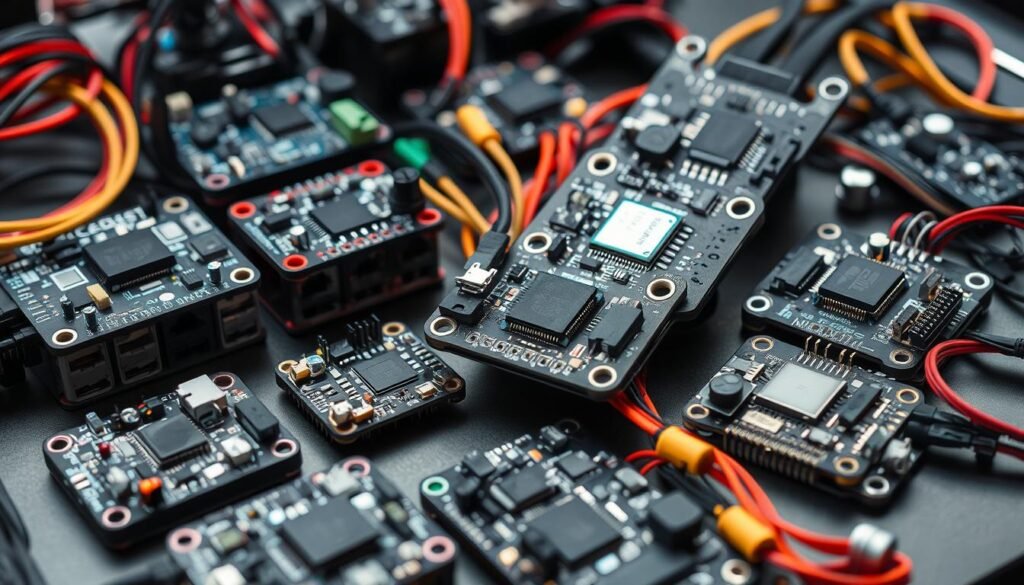
Selecting the Right Flight Controller
When choosing a flight controller, consider these factors:
- Compatibility with your other components, such as ESCs, receivers, and sensors
- Processing power and memory to handle complex algorithms and real-time data processing
- Firmware support and customization options to tailor the flight characteristics to your preferences
- Size and weight to ensure proper fitment and balanced weight distribution
- Price and value for money, considering the features and capabilities offered
Flight controllers are available for every budget and skill level. Prices range from $12.99 to $78.99. Some popular options include the SEQURE H743 V2 & E70 G2 Stack FC ($116.00).
Other choices are the SEQURE H743 V2 ICM42688P FC ($41.99) and the SEQURE H743 MPU6000 FC 4-8S Dual BEC ($69.99 with a 19% discount).
Investing in a quality flight controller is crucial for achieving optimal performance and reliability in your DIY drone build.
Understanding flight controller types, features, and selection factors is vital. This knowledge helps you make an informed decision and build a drone that meets your needs.
Electronic Speed Controllers (ESCs)
ESCs are vital for controlling drone motors. They regulate speed and direction based on flight controller input. ESC ratings vary from 20A to 40A, depending on motor requirements.
For optimal performance, choose ESCs with 10-20% higher current ratings than your motors’ maximum draw. This ensures longevity and smooth operation.
ESCs come as individual units or 4-in-1 boards. Single ESCs weigh 4-6 grams, while quad ESCs are 12-15 grams. Consider firmware compatibility, protocol support, and built-in features when selecting ESCs.
Popular ESC firmware options include:
- BLHeli_S
- BLHeli_32
- BLHeli
- KISS
These firmware types offer customization options for fine-tuning drone performance. ESCs support various communication protocols, from standard PWM to advanced Multishot and Dshot.
| ESC Protocol | Packet Transmission Speed |
|---|---|
| Standard PWM | 1-2 ms |
| Oneshot125 | 125-250 µs |
| Oneshot42 | 41.7 µs |
| Multishot | 5-25 µs |
| Dshot150/300/600/1200 | 6.67-0.83 µs |
Choose ESCs compatible with your motors, battery, and flight controller. High-quality ESCs from reputable brands enhance drone performance and reliability.
Investing in the right ESCs can significantly improve your overall flying experience. Consider all factors carefully when making your selection.
Drone parts: Batteries and Power Distribution
Powering your drone is crucial for DIY and custom builds. The right batteries and power distribution components ensure top performance. LiPo batteries are popular due to their high energy density and discharge rates.
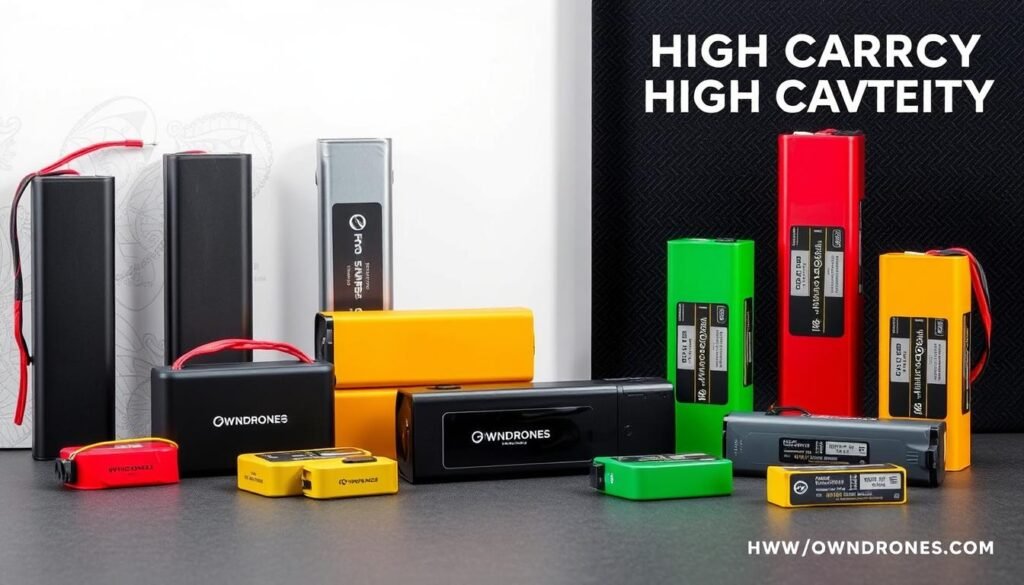
LiPo Batteries for Drones
When picking LiPo batteries for your drone, consider these factors:
- Battery capacity (mAh): Higher capacity means longer flight times.
- Voltage (S): Most drones use 3S to 6S batteries, with each “S” representing 3.7 volts.
- C-rating: This indicates the maximum discharge rate. Higher C-ratings are suitable for high-performance drones.
Here are some popular LiPo battery options for drones:
| Battery | Capacity | Voltage | Price |
|---|---|---|---|
| Tattu Plus 22000mAh 6S | 22000mAh | 22.2V | $319.00 |
| Foxtech 6S 12500mAh Li-ion | 12500mAh | 22.2V | $239.00 |
| Tattu 6S 12000mAh HV | 12000mAh | 22.8V | $249.00 |
Power Distribution Boards
Power distribution boards (PDBs) make wiring easier. They provide a central hub for power and signal connections. PDBs distribute battery power to the flight controller, ESCs, and other parts.
Some PDBs also have built-in voltage regulators and current sensors.
Battery Connectors and Wiring
Safe drone operation requires secure and reliable battery connections. XT60 and XT30 connectors are popular due to their high current capacity. Use the right wire gauge to prevent overheating and power loss.
LiPo batteries are among the most common battery types used for drones, as they offer high energy density, a higher voltage per cell, and can power onboard systems with fewer cells than other rechargeable batteries.
Careful selection of drone batteries, power distribution boards, and connectors is key. This ensures your custom-built drone has a reliable and efficient power system.
FPV Cameras and Video Transmitters
FPV cameras and video transmitters are key for live drone footage. They bring the thrill of flying from a bird’s eye view. This makes FPV flying an exciting, immersive experience.
Types of FPV Cameras
FPV cameras vary in size, resolution, and field of view. Brands like RunCam and Foxeer offer many options. When choosing, look at image quality, low-light performance, and compatibility.
Analog systems are much cheaper than digital ones. They often cost one-third to one-fifth of the price. Many top racers now use HDZero for better image quality and performance.
Video Transmitters and Receivers
Video transmitters (VTX) send camera feed to ground stations or goggles. The most common frequency is 5.8GHz. Choose a VTX based on power output, channel support, and compatibility.
Receivers like ImmersionRC RapidFire offer diversity and auto-scanning. These features help maintain a stable video feed. Receiver diversity switches between two antennas for the strongest signal.
Antennas and Receiver Diversity
Antennas are crucial for signal strength and range. Various types exist, including polarized and directional designs. The right antenna can greatly improve your FPV experience. It reduces signal interference and extends video feed range.
| FPV System | Advantages | Disadvantages |
|---|---|---|
| Analog | Low cost, low latency, compatibility with race timing systems and DVRs | Lower image quality compared to digital systems |
| HDZero | Better image quality than analog, competitive advantage for racing | Higher cost compared to analog systems |
| DJI FPV | High-resolution OLED screens, compatibility with OcuSync V3 protocol | Proprietary system, limited compatibility with other components |
Choose an FPV system based on your specific needs. Analog systems are great for racing. They offer low latency and work well with race timing systems.
For smaller drones with wheelbases around 95mm, analog systems work better. They have smaller, lighter transmitters that suit these drones well.
Radio Control Systems
Precise drone piloting requires a reliable radio control system. It includes a handheld transmitter and a receiver on the drone. The transmitter sends signals to the receiver, which then controls the drone’s components.
When choosing a radio control system, consider range, channels, and compatibility. Popular brands like FrSky, Spektrum, and Futaba offer various options. These brands cater to different needs and budgets.
Radio Transmitters and Receivers
Radio transmitters come in simple and feature-rich designs. Pick a comfortable transmitter with necessary controls for your drone. Ensure it meets your specific needs.
Select receivers based on compatibility with your transmitter and flight controller. Check for protocol support like SBUS, PPM, or DSMX. Consider size, weight, and antenna configuration for proper fit and signal reception.
Binding and Failsafe Settings
Binding pairs your transmitter with the receiver for secure communication. Follow the manufacturer’s instructions to enter “bind mode” on both devices. Once bound, they’ll connect automatically when powered on.
Failsafe settings ensure drone safety if signal is lost. They determine the drone’s response to connection loss. Options include returning home, hovering, or controlled descent. Configure failsafe settings according to preferences and local rules.
Consider these statistics when shopping for radio control systems:
- Save 75% on DJI Zenmuse H20T Thermal (Open Stock)
- Save 20% on Zenmuse P1 – Service Replacement
- Save 50% on DJI FPV Remote Controller 2 Antenna Board (Black Cable)
- Save 9% on DJI RC GPS Button Board
- Save 33% on DJI RC Plus MicroSD Card Slot Dustproof Cover
- Save 50% on DJI FPV Remote Controller 2 Antenna Rotating Shaft
- Save 33% on DJI RC Plus Control Stick Protective Ring
- Save 33% on DJI RC Plus USB-C Port Dustproof Cover
DSLRPros offers quality drone remote controllers, receivers, and accessories. They ensure optimal performance and compatibility for DIY drone builds. With expert support, DSLRPros is ideal for pilots seeking reliable radio control solutions.
Additional Accessories and Components
Custom drones can be enhanced with various accessories and components. These include GPS modules, telemetry systems, buzzers, LED indicators, landing gear, and camera mounts. Each item adds unique capabilities to your drone.
GPS Modules
GPS modules enable features like position hold and return-to-home. They help maintain stability in windy conditions and locate lost drones. Choose a module compatible with your flight controller for best results.
Consider the number of satellite constellations it supports. More constellations can improve accuracy and overall performance.
Telemetry Systems
Telemetry systems provide real-time data on your drone’s performance. They transmit information like battery voltage and signal strength to your ground station. This data helps you make informed decisions during flight.
These systems are crucial for long-range flights. They can prevent accidents caused by low battery or signal loss.
Buzzer and LED Indicators
Buzzers and LED indicators help locate your drone and monitor its status. Buzzers emit tones to find crashed drones in tall grass. LEDs provide visual cues about flight mode and battery level.
These components are especially useful when flying in low-light conditions. They also help when your drone is far away.
Landing Gear and Camera Mounts
Landing gear protects your drone during takeoff and landing. It absorbs impact and prevents damage to the frame and components. Camera mounts stabilize footage by reducing shake from drone vibrations.
Choose landing gear and mounts based on your drone’s size and weight. Consider your intended use to ensure proper fit and functionality.
| Component | Purpose |
|---|---|
| GPS Module | Position hold, return-to-home, waypoint navigation |
| Telemetry System | Real-time data on battery voltage, signal strength, and flight parameters |
| Buzzer | Audible tones for locating crashed or landed drones |
| LED Indicators | Visual cues for flight mode, battery level, and status |
| Landing Gear | Impact absorption during takeoff and landing |
| Camera Mounts | Stabilization for cameras and payloads |
Conclusion
Building custom drones is an exciting journey. It lets you create a machine that fits your needs perfectly. Understanding essential drone parts helps you make smart choices when selecting components.
Popular brands like T-Motor, EMAX, and Gemfan offer quality motors and propellers. Lithium polymer (LiPo) batteries provide a high power-to-weight ratio. Each part plays a crucial role in your drone’s performance.
When picking components, consider compatibility, budget, and quality. Invest in high-quality parts for critical components like motors and flight controllers. This ensures optimal performance and longevity.
Avoid overspending on unnecessary upgrades. Pay attention to compatibility issues such as voltage, power output, and size. These factors can greatly impact your drone’s overall performance.
The drone industry is rapidly advancing. Stay informed about new trends and innovations to enhance your building experience. DIY drone building offers endless possibilities for beginners and experienced enthusiasts alike.
Prioritize safety and responsible flying practices. This minimizes risks and ensures compliance with regulations. With the right knowledge and components, you can create an unforgettable flying experience.
